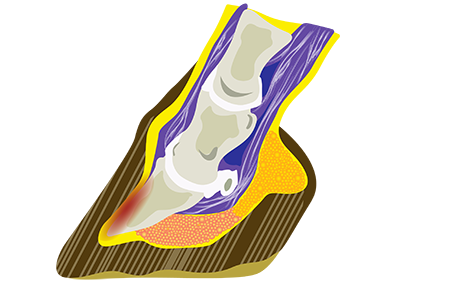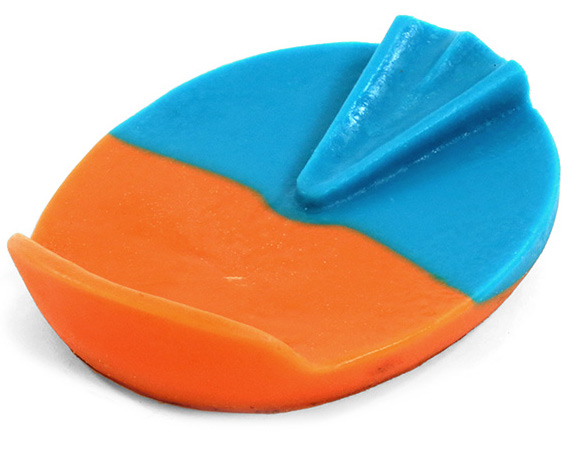Focus on Laminitis Edition
|
|
|
In most of the country the birds are singing, the sun is out, and the grass is getting green. In the horse world we’re shedding our coats- both the puffy jackets and the long fur - and gearing up for everything warmer weather brings. Unfortunately, with all the sunshine and roses of spring, it can also bring on more bouts of laminitis. Something nobody wants to see.
In this edition we’re touching on the basics of laminitis:
- What it is
- Common causes and symptoms
- How Soft-Ride’s products can help your horse
Soft Ride Team
|
|

|
What a Healthy Horse Foot Looks Like
|

|
What a Laminitic (lame) Horse Foot looks like
|
|
|
Laminitis results from the disruption of blood flow to the sensitive and insensitive laminae. These laminae structures within the foot secure the coffin bone (the wedge-shaped bone within the foot) to the hoof wall. Inflammation often permanently weakens the laminae and interferes with the wall/bone bond. In severe cases, the bone and the hoof wall can separate. In these situations, the coffin bone may rotate within the foot, be displaced downward ("sink") and eventually penetrate the sole. Laminitis can affect one or all feet, but it is most often seen in the front feet.
|
|
|
The terms "laminitis" and "founder" are used interchangeably. However, founder usually refers to a chronic (long-term) condition associated with rotation of the coffin bone, whereas acute laminitis refers to symptoms associated with a sudden initial attack, including pain and inflammation of the laminae.
|
|

|
|
© Dr. Christoph von Horst
|
|
There is no one cause for laminitis. While laminitis occurs in the hoof, it may be caused by a number of factors elsewhere in the horse, including but not limited to:
- Excessive shifting of weight to one leg due to injury to another leg, also known as support limb laminitis
- Insulin resistance and obesity, particularly in horses that are chronically overweight
- Consuming more carbohydrates than a horse’s body can process, such as when a horse gorges on lush spring grasses
- Absorption of bacterial toxins- can be from infected organs or compromised GI tract
|
|
- A horse suffering from laminitis frequently stands with their front feet pushed out in front and the hind feet farther under their body than normal
- If the laminitic horse is willing to walk, it walks with a short stride, trying to get each foot back on the ground as quickly as possible. Turning in tight circles can also be painful.
- A laminitic horse will stand with hind feet brought forward under its belly trying to shift most of its weight from the front feet
- Inflammation in the hoof or a bounding digital pulse
|
|
|
If you suspect laminitis, contact your vet immediately. The earlier a case of laminitis is diagnosed and treatment begins the better. No single treatment will help with every case of laminitis, but industry standards suggest several treatments.
|
|
1. Ice
Specifically the 72 hour cryotherapy protocol which calls for long duration submersion in cold water and ice. Learn more below by clicking on the link to Dr. James Belknap’s video.
|
|

|
|
Dr. James Belknap explains Cryotherapy and how the Ice Spa works.
|
|
2. Support
Getting a horse on a comfortable, supportive platform that encourages blood flow through the hoof as well as more comfortable movement for the horse is critical for recovery. Soft-Ride’s gel orthotics are designed to support the horse’s foot and encourage increased circulation by loading and unloading the sole. The dual-density orthotic is specifically designed for laminitic cases by providing a softer platform and less pressure in the front of the hoof under the coffin bone, while keeping a firmer platform in the heel.
|
|

|
Specialty Orthotic - Purple / Turquoise
The purple/turquoise specialty gel orthotic is ideal for use on horses with laminitis.
|

|
Specialty Orthotic -
Orange / Turquoise
The orange/turquoise specialty gel orthotic is ideal for use on larger, heavier horses with laminitis, or to provide a smaller angle of the hoof to relieve tendon tension.
|
|
3. Corrective Shoeing
giving a horse full sole support, continuing to encourage positive circulation by loading and unloading the sole, and providing a rockered bottom to provide a breakover that doesn’t strain the ligaments and tendons are all important parts of keeping a foundered or post-laminitic horse comfortable on the road to recovery. Softrider Max Shoes can be nailed, cast, or elisticoned to the hoof for a long term wear solution.
|
|
|
SoftRider Max being temporarily attached using elasticon tape to ensure proper angle placement and comfort. Learn more about attaching SoftRider shoes with or without nails in these videos:
|
|

|
|
Equine veterinarian Dr. Joe Stricklin, and farrier Craig Doolittle, demonstrate how SoftRiders helped a sore-footed horse by providing cushioning and ease of breakover.
|
|

|
|
Stuart Muir: Full Casting Video NEAEP
|
|
Soft Ride on the Road - Spring Season
|
|

|
Farrier Collaboration: Radiograph Assisted Management of the Equine Athlete
|
|
NAEP along with Dr. Kit Miller and Mr. Mike Wildstein will be presenting a collaborative session centered around discussing radiographs between veterinarian and farriers - how to approach the topic, what are important aspects to focus on, and how to look at the horse’s foot conformation. The focus will be on radiographic anatomy of the foot including basic radiographic anatomy of the digit and important measurements to consider when taking radiographs for the farrier and veterinarian.
Mr. Stuart Muir will apply SoftRider shoes as part of the lab portion of this event.
Event Information:
Storm Harbor Equestrian Center
April 5-6, 2024
245 Harmony Rd.
Slippery Rock, PA, 16057
Contact: https://www.thenaep.com/events/regionalwetlabpenn
|
|

|
Rood and Riddle International Podiatry Summit
|
|
The International Podiatry Conference aims to bring together experienced equine veterinarians and farriers for skill development and discussion. The ability to meet and discuss techniques will help advance the skill set of all attending, raise new questions, formulate new areas of research, and facilitate contacts between veterinarians and farriers. This conference will feature lectures, demos, and hands-on wet labs for participating vets and farriers.
Event Information:
Rood & Riddle Equine Hospital
April 18-20, 2024
2150 Georgetown Rd
Lexington, KY 40511
Contact: https://form.jotform.com/233463971873164
|
|

|
Ignite for Equine Athletes : From the Ground Up
|
|
This conference is directed to farriers, veterinarians, equine podiatrist and footing experts. The two day conference will include topics like static and dynamic observations of the hoof, diagnostic imaging modalities, rehabilitative shoeing, and regional foot perfusion.
Equine Podiatry speakers will include: Dr. Mark Revenaugh, Dr. Mark Silverman, Dr. Bart Halsberghe, Didier Rondelez, Dr. Kurt Selberg, Dr. Lars Roepstorff, Dr Britt Conklin, Robert Jukes, Dr. Charlie Buchanan, Pete May, Kyle Kukla, Dr. David Dutton, Dr. Matt Durham, Steve Teichman, Tim Ober, Elin Hernlund, Dr. Jim Meyers, and Beau Whitaker.
Event Information:
Brazos Valley Equine and Shady Villa Hotel
April 26-27, 2024
1920 FM 2268 Salado TX 76571
Contact: https://www.igniteforequineathletes.com/from-the-ground-up
|
|

|
New Developments in Management of Acute & Chronic Laminitis
|
|
|
This online panel will discuss the latest research and developments in the management of laminitis in both acute and chronic cases. The discussion will be lead by Dr. Andrew Van Eps, Dr. Edd Knowles, Dr. Fran James, and Dr. Jaret Pullen.
Event Information:
Online Panel Discussion
May 7th, 2024 - local times vary
Contact: https://www.vetpd.com/online-learning-center/equine/panel-discussions/course-detail/online-panel-discussion-%E2%80%93-new-developments-in-management-of-acute-&-chronic-laminitis
|
|

|
|
I just wanted to drop a quick note to say thank you. I can't tell you how thankful I am for your Soft Ride Boots, they have truly saved my horse. Cody is a 21 year old quarter horse with navicular and has battled hoof issues off and on for the entire 15 years I have owned him. Cody has been retired for about 6 years due to all the issues with his feet and the changes it did to his back. In February he came up lame, we did x-rays and initially there was no sign of laminitis and treated with an anti-inflammatory. The situation got worse over the course of a week or so and his comfort level declined to the point of having a very difficult discussion with the vet about what my options were as I never want him to be in any pain and if he was facing a negative quality of life, I couldn't do that to him. After going over the options we decided to do more x-rays with shoes off and work with my farrier on therapeutic shoeing and a dose of Osphos to see if we could make him comfortable. Before we could do the next set of x-rays he declined even more and showed definite signs of laminitis. We immediately pulled his shoes and put a pair of Soft Ride Boots on him that another horse had used. I was amazed at how much just him being in the boots made him more comfortable instantly, you could see it in his face and body. We kept these on him until I could overnight his own pair. Each day he improved, I can't tell you how amazed we all were that between that Saturday and his x-rays 4 days later how shocked we all were to see him walk sound. He continues to wear the boots and he continues to walk sound - here is the other amazing thing - he has been on Equioxx for years and when he has been taken off for even a day, he comes up lame until now - he has been off all pain meds for a week now and he is sounder than he has ever been. I got to the barn the other night and my friend who has known Cody as long as I have said - look at this and pulled him out of his stall and walked him down the aisle - he is moving better than I have seen him in years. I can't thank you enough for giving me Cody relief and hopefully a few more years of a good quality of life. I have gone from crying daily at the barn to actually being relaxed again not seeing him in pain.
Truly thank you, I can't say it enough.
Karen and Cody
|
|
We LOVE hearing from our customers and getting updates on how your horses are doing! Please send us your story and a photo of your horse in their Soft Ride products for a chance to be featured on our social media, in an upcoming issue of our newsletter, and to be entered in a Soft Ride giveaway!
Email us here: socialmedia@srboots.com
Tag us:
Facebook: Soft Ride Equine Comfort Boots
Instagram: @soft.ride
|
|
Thanks for Reading!
If you have a friend you think would be interested in our content you can share with the social icons below.
|
|
|
As we continue our drive to keep your horse on his feet, we've received more than 15 patents, ship to over 50 countries, and work with more than 6,000 veterinarians around the world, as well as every veterinarian school in the United States, Canada, Europe and Australia. And with horse owners from every discipline using our products, we can safely and proudly say, "The best in the world rely on Soft Ride."
|
|
|
|


